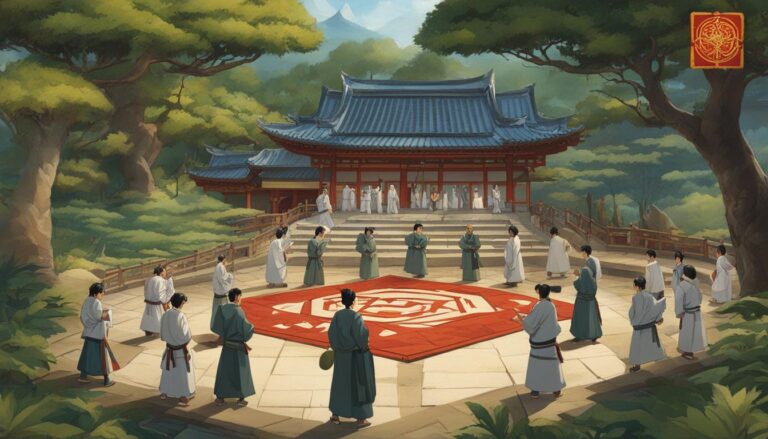Disclosure: This Post Contains Affiliate Links; We earn a commission on purchases.
Are you ready to dive into the world of Go strategy? Whether you’re a beginner looking for tips or an experienced player seeking advanced strategies, this article has got you covered. Go is an ancient board game that has been played for over 2,500 years, originating in China. It is a game of skill, strategy, and anticipation, played on a grid of 19×19 lines.
In Go, the objective is to outmaneuver your opponent and capture more territory on the board. The game involves intricate strategies that can be employed at different stages, from the opening moves to the endgame. If you’re new to Go, don’t worry! We’ll provide you with beginner tips to get started, and if you’re already familiar with the game, we’ll take you through advanced strategies to sharpen your skills.
Playing Go requires a deep understanding of the game’s principles and techniques. From mastering the art of reading your opponent’s moves to creating harmonious positions on the board, every move can make a significant difference in the outcome. We’ll guide you through various aspects of Go strategy, including opening theory, connection and separation, life and death situations, reading ahead, and building balanced positions. Along the way, we’ll share insights from famous Go games to showcase the depths of the game’s strategy.
But Go is more than just a game. Its lessons can extend beyond the board and into our lives. By applying the principles of resilience, adaptability, and balance that Go instills, we can improve our decision-making abilities and strategic thinking in various situations.
Key Takeaways:
- Go is an ancient board game that requires strategic thinking and anticipation.
- Beginner players can learn the basics of Go strategy, while advanced players can enhance their skills with advanced strategies.
- Mastering the various aspects of Go strategy, such as reading ahead and creating harmonious positions, is crucial for success.
- Analyzing famous Go games offers valuable insights into the game’s strategic depth.
- The lessons learned from Go strategy can be applied to various aspects of life, promoting resilience, adaptability, and balance.
Table of Contents
Understanding the Basics of Go Opening Theory
When it comes to Go strategy, understanding the basics of opening theory is crucial for success. The opening stage of a Go game is known as fuseki, which involves establishing a solid foundation and setting the tone for the rest of the game.
The key principle in Go opening theory is the concept of “corner, side, center.” This approach focuses on capturing territory in the corners first, followed by the sides, and ultimately, the center.
The opening moves in Go are typically played on or near the 4-4 star points in the corners. These strategic positions provide a strong base and allow for future expansion into different areas of the board.
To develop corner positions effectively, players often rely on standard sequences called josekis. These josekis are well-established patterns that have been studied and refined over the centuries.
“Corner positions, side influence, and center control are the pillars of Go opening theory. By understanding and utilizing these principles, players can lay a solid foundation for their strategy.”
By mastering the fundamentals of Go opening theory, players gain a deeper understanding of the game’s strategic elements. This knowledge sets the stage for the subsequent phases of a Go game, where tactics and counterplay come into play.
Strategic Placement of Stones
Table: Strategic Placement of Stones in Go Opening
| Corner | Side | Center | |
|---|---|---|---|
| Objective | To secure territory | To expand influence | To control the game |
| Key Moves | 4-4 star points or adjacent positions | Adjacent to corners or on 3rd or 4th lines | 3rd or 4th lines or towards open areas |
| Importance | Crucial for early advantage | To establish framework | For strategic flexibility |
Understanding the basics of Go opening theory sets the stage for a solid strategic foundation. By employing corner-based openings, players can secure territory and establish a framework for future expansion. Additionally, focusing on the center allows for strategic flexibility and control over the game. With a strong understanding of opening theory, players are well-equipped to navigate the complexities of Go strategy.
Mastering Connection and Separation in Go Strategy
In the game of Go, the connection and separation of stones play a vital role in strategic decision-making. Understanding how to connect one’s own stones and separate the opponent’s stones can greatly impact the outcome of the game.
When stones are connected in Go, they become stronger and more secure. Connected stones can support each other, share liberties, and create a solid foundation for future moves. By maintaining a strong connection, players can fortify their positions and make it more challenging for the opponent to capture their stones.
On the other hand, the tactic of cutting is used to divide and separate the opponent’s stones. Cutting strategically weakens the opponent’s group, disrupts their plans, and creates opportunities for further tactical maneuvers. It is a powerful technique to exploit weaknesses in the opponent’s position and gain a competitive advantage.
However, the balance between connection and separation is crucial. Overconnecting can lead to inefficiency and lack of flexibility, making it easier for the opponent to exploit gaps in the player’s position. Conversely, cutting without careful consideration can result in fragmented and vulnerable stones.
Strategic players in Go understand the importance of tactical connection and separation. They carefully assess the board situation, evaluate the strength and vulnerabilities of their stones, and make calculated decisions to strengthen their position while weakening their opponent’s. It requires a deep understanding of the game and the ability to read ahead to anticipate the consequences of different moves.
Key Points:
- Connecting stones enhances their strength and makes them harder to capture.
- Cutting is a tactic to divide and weaken the opponent’s stones.
- Strategic players strike a balance between connection and separation to create a resilient and flexible position.
By mastering the art of connection and separation in Go strategy, players can elevate their gameplay and increase their chances of success.
Illustration: Connecting and separating stones strategically in Go can significantly impact the outcome of a game.
Life and Death in Go Strategy
Life and death play a pivotal role in Go strategy. In this section, we will explore the concept of life and death and its significance in the game.
In Go, groups of stones can be classified as alive, dead, or unsettled based on their ability to avoid capture. Determining the life and death status of these groups is essential for strategic decision-making.
Go puzzles, also known as Tsumego, are widely used to improve players’ skills in reading and evaluating the life and death status of groups. Tsumego challenges players to analyze complex board positions and identify the correct moves to ensure the survival or elimination of groups.
To create groups that cannot be killed, players must understand the concept of eyes. In Go, eyes are essential for the survival of groups as they provide vital internal liberties, making it impossible for the opponent to capture the group.
“In every stone, there is the potential for both life and death. Mastering the art of life and death is mastering the essence of Go.”
Developing a deep understanding of the life and death aspect of Go is crucial for strategic success. By improving their ability to read and evaluate the status of groups, players can make informed decisions and gain a competitive edge on the board.
Classification of Stone Groups in Go
| Classification | Description |
|---|---|
| Alive | Groups that cannot be captured due to the presence of at least two eyes. |
| Dead | Groups that can be captured by the opponent, lacking sufficient liberties or eyes. |
| Unsettled | Groups that have not yet established a clear status and require further play to determine their fate. |
Understanding the classification of stone groups in Go provides players with a strategic framework for assessing the strengths and weaknesses of their own and their opponent’s positions. By recognizing the vital importance of life and death, players can develop a more nuanced approach to their gameplay.
Next, we will delve into the art of reading and anticipating moves in Go strategy, a crucial skill for successful gameplay.
Reading and Anticipating Moves in Go Strategy
Reading ahead is a crucial skill in Go strategy. It requires the ability to analyze positions, predict opponent’s moves, and make strong tactical plays. By thinking several moves ahead, players can anticipate the unfolding of the game and make informed decisions.
When reading ahead, players must carefully consider each move’s potential outcomes and how they will impact the overall game. This involves analyzing the positions on the board and identifying the best course of action based on the current state of play.
For example, let’s say you’re playing Go, and your opponent places a stone near your territory. By reading ahead, you can analyze potential responses and their consequences. You might anticipate their intention to invade your territory, prompting you to reinforce your defenses or counter-attack strategically.
This level of analysis and prediction allows you to set priorities and adapt your strategy accordingly. It also enables you to identify weaknesses in your opponent’s plans and exploit potential vulnerabilities in their positions.
Strategic Reading for Opportunities
Reading ahead is not only about analyzing your opponent’s moves but also about seeking opportunities to gain an advantage. By predicting your opponent’s next moves, you can anticipate their intentions and strategize accordingly.
“Reading ahead is like peering into the future of the game. It provides you with a valuable edge over your opponent, allowing you to make calculated moves and gain a strategic advantage.” – Go Master Yuta Iyama
Strong tactical play in Go relies heavily on the ability to read ahead and make informed predictions. It requires a deep understanding of the game’s principles and techniques, as well as the intuition to make decisive moves.
To strengthen your reading ability, it is essential to practice regularly and analyze professional game records. Studying famous games played by Go masters can provide valuable insights into reading techniques and strategic thinking.
Now, let’s take a moment to examine a real-life example of reading and anticipation in Go:
| Position | Player | Move | Predicted Response |
|---|---|---|---|
| 1 | Black |  | White F3 |
| 2 | Black | E4 | White C3 |
| 3 | Black | D3 | White D2 |
Table: Example of reading ahead and predicting opponent’s moves in Go
In this example, the black player strategically reads ahead and anticipates White’s responses. By carefully considering the potential consequences of each move, they are able to make calculated and strategic moves, gaining an advantage in the game.
By honing your ability to read ahead and anticipate moves, you can enhance your tactical play in Go and increase your chances of success. Reading the board, analyzing positions, and predicting opponent’s moves will give you the upper hand in this ancient game of strategy.
Building Harmonious Positions in Go Strategy
When it comes to playing Go, the creation of balanced and harmonious positions on the board is of utmost importance. By strategically placing stones on the third and fourth lines, players can achieve territorial gains and exert influence over the center of the board. This approach allows for a harmonious distribution of power and control.
Creating thickness and lightness in positions is crucial for successful strategic play in Go. When stones form a strong and secure connection, they radiate influence and provide a solid foundation for further moves. This balanced positioning enables players to maintain control over key areas of the board while simultaneously defending their own territory.
Strategic Connection of Stones
In the game of Go, the strategic connection of stones is a vital aspect of achieving a harmonious position. When stones are connected, they support each other and can combine their strength to create a formidable force. This connection ensures that players have a strong presence on the board and can effectively counter their opponent’s moves.
Players strategically connect stones by placing them in close proximity to each other, establishing a network of influence. This network allows for the seamless flow of power throughout the board, enabling balanced positions and harmonious play.
Harmonious Play
Harmonious play in Go involves finding the delicate balance between offense and defense, territory and influence. It requires players to anticipate their opponent’s moves and strategically position their stones to maximize their potential. By maintaining a harmonious playstyle, players can adapt to changing conditions on the board and make informed decisions that lead to victory.
“A harmonious position in Go is like a symphony, with each stone playing its part in the overall strategy.”
Creating a harmonious position in Go is an art that requires patience, foresight, and a deep understanding of the game. It is a testament to the strategic brilliance and complexity of this ancient board game.
| Benefits of Building Harmonious Positions in Go Strategy | How to Achieve Harmonious Positions |
|---|---|
|
|
The Deep Insights of Go Strategy from Famous Game Examples
Famous Go games offer valuable insights and lessons that go beyond the game itself. Analyzing the moves and strategies used in these games can provide deep insights into Go strategy and improve players’ understanding of the game.
“Analyzing famous Go games is like unraveling the secrets of a master strategist. Each move holds strategic significance and offers players a glimpse into the intricate web of strategic thinking.” – Go Master
One such famous game that showcases the strategic depth of Go is the “ear-reddening move” game between Honinbo Shusaku and Gennan Inseki. In this game, Honinbo Shusaku played a move that greatly surprised his opponent, leading to intense battles and strategic maneuvering.

Studying famous Go games like this provides players with valuable insights into different strategic approaches and the nuances of gameplay. It allows them to expand their repertoire of strategic moves and improve their overall gameplay.
The Strategic Insights from Famous Go Games
1. Recognizing pivotal moments: Famous Go games often feature critical moments where one move can dramatically alter the outcome of the game. Analyzing these moments helps players develop an eye for recognizing pivotal moments in their own games.
2. Innovative strategies: Famous games often showcase innovative and unconventional strategies. Studying these strategies expands players’ strategic thinking and encourages them to explore new approaches in their own gameplay.
3. Tactical brilliance: Famous games highlight tactical brilliance, demonstrating how intricate moves can lead to significant advantages. Studying the tactics used by top players enhances players’ ability to spot tactical opportunities and execute winning moves.
The Lessons from Famous Go Games
1. Think outside the box: Famous games inspire players to think creatively and experiment with unconventional strategies. Thinking outside the box can lead to unexpected victories and fresh approaches to the game.
2. Adaptability is key: Famous games often showcase players adapting their strategies based on the changing board positions. Learning to adapt flexibly to different situations can greatly improve a player’s overall gameplay.
3. Develop a deep understanding: Studying famous games helps players develop a deep understanding of the different aspects of Go strategy, such as territory control, strategic positioning, and influence. This deep understanding allows players to make informed decisions and anticipate their opponent’s moves.
By delving into famous Go games, players can gain a deep understanding of the game and discover new strategic insights that can elevate their gameplay to new heights.
Applying Go Strategy Lessons to Life
Go strategy goes beyond the game itself and offers valuable insights and life lessons. By immersing themselves in the complexities of the game, players can develop qualities such as resilience, adaptability, patience, and balance, which are essential for success in various aspects of life.
The game of Go requires resilience, the ability to bounce back from setbacks and forge ahead despite challenges. Just like in Go, where even the most skilled players face unexpected obstacles, life often throws curveballs that require resilience to overcome.
Adaptability is another valuable lesson from Go strategy. In the game, players must adapt their plans and strategies based on the flow of the game and the moves of their opponents. Similarly, in life, being adaptable allows us to navigate unpredictable situations, adjust our approach, and find new solutions.
Patience is a fundamental quality for both Go strategy and life. In Go, patience is required to carefully analyze the board, anticipate moves, and plan effective strategies. The same goes for life, where patience allows us to make well-thought-out decisions, endure challenges, and pursue long-term goals.
Balance is a key principle in Go strategy, and it is equally important in life. In the game, players must find a balance between offense and defense, territorial gains, and strategic influence. In life, balance helps us maintain mental and emotional well-being, manage priorities, and harmonize various aspects of our lives.
Studying classic Go games and understanding the strategies employed by top players can deepen our appreciation for the game and provide valuable insights for life. Just as in Go, where players analyze patterns, read the board, and gain strategic insights, these skills can be transferred to various situations we encounter, allowing us to make better decisions and approach challenges with a strategic mindset.
“Life is like a game of Go, where the only way to excel is to patiently observe, adapt, and find a balance between different aspects.”
Applying Go strategy lessons to life can empower individuals to thrive amidst uncertainty, embrace challenges, and approach decisions with a strategic perspective. The valuable qualities of resilience, adaptability, patience, and balance gained through the game can serve as pillars for personal growth and success.
The Role of Go Engines and the Value of Classic Games
While technology has greatly advanced the understanding and play of the game, it is important to recognize the value of studying classic Go games and learning from the strategies of top players. The advent of Go engines and artificial intelligence in Go has revolutionized the way the game is played, allowing for enhanced analysis and gameplay. However, there are certain aspects of the strategic depth of Go that may not be fully captured by AI.
Classic games, such as the famous “ear-reddening game,” offer invaluable insights into the complexities of Go strategy. These historic games played by esteemed Go masters provide a wealth of knowledge and inspiration for both beginners and advanced players alike. Studying the moves and strategies used in these games helps players develop a deeper understanding of the game and refine their own gameplay.
Learning from classic Go games allows players to grasp the timeless principles and dynamics that have shaped the game for centuries. By analyzing the decisions made by legendary players like Honinbo Shusaku and Gennan Inseki, players can gain a profound appreciation for the strategic intricacies of Go.
Benefits of Studying Classic Go Games:
- Insights into strategic decision-making
- Understanding of positional play
- Visualization of tactical maneuvers
- Improvement of reading abilities
- Appreciation for the historical significance of the game
By combining the knowledge gained from classic Go games with the analytical capabilities of Go engines, players can further enhance their gameplay and strategic thinking. The marriage of traditional wisdom with modern technology opens up new avenues for exploration and innovation in the world of Go.
Studying classic games is like delving into the rich tapestry of Go’s history, unraveling the strategies of old masters, and breathing new life into our own gameplay.
So, while Go engines provide valuable insights and analysis, they should not overshadow the enduring wisdom and ingenuity contained within classic Go games. By learning from both artificial intelligence and the masters of the past, players can truly unlock the full potential of Go strategy.
Conclusion
Go Strategy is an ancient game of immense strategic depth that continues to captivate players around the world. By delving into the tactics, openings, and concepts of Go, players have the opportunity to enhance their strategic thinking and decision-making abilities.
Mastering the game requires study and understanding of classic games, such as the legendary “ear-reddening move” game. These games offer valuable insights and lessons that go beyond the game itself, providing a deep understanding of Go strategy.
Through Go Strategy, players can develop skills that extend to various aspects of life. The ability to adapt, balance, and persevere gained from playing Go can be applied to real-world situations, making it a valuable investment of time and effort.

As the founder of Friends Game Night, Ryan channels his enthusiasm for gaming into a platform that celebrates the magic of gathering friends around the digital or physical tabletop. Through his website, Ryan shares insightful articles, reviews, and recommendations, aiming to inspire others to create their own memorable gaming moments.
Subscribe to Our Newsletter










